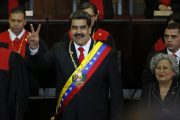The current United Nations climate change conference in Lima, Peru, is on track to have the largest carbon footprint of any UN climate conference to date, the Associated Press reports.
All told, the 13-day conference is expected to emit over 50,000 metric tons of carbon dioxide, about half again as much as the average climate confab, said UN Development Program project coordinator Jorge Alvarez. That, notes the AP, “is what China as a country emits in three minutes, the U.S. does in five minutes and host nation Peru does in six hours and 40 minutes.”
As always, the amount of jet fuel needed to transport foreigners to the anti-fossil-fuel conference — there are an estimated 11,000 delegates and observers in Lima — accounts for a large chunk of the emissions: about 30 percent.
Most of the rest of the emissions are attributable to the fact that UN organizers cared so much about their carbon footprint that they chose to hold their conference in a city that would have to construct a venue for the meeting from the ground up. That required burning fossil fuels to manufacture, transport, and install “eleven football fields of temporary structures,” including flying some components in “from as far as France and Brazil,” according to the AP. Construction alone accounts for around 20 percent of the confab’s carbon emissions.
Then there is the fact that practically everyone attending the conference is arriving in a carbon-belching vehicle of one kind or another. There’s no public transportation to the newly constructed venue, so organizers had to hire over 300 gas-guzzling buses to bring people to it. “Most delegates,” says the AP, “spend about an hour in traffic traveling less than 6 miles (10 kilometers) from their hotels.” There is a bicycle parking lot, constructed at the behest of Peruvian environment minister Manuel Pulgar-Vidal, but hardly anyone uses it. And there are no hybrid or electric vehicles at the conference despite a Japanese donation of 121 such vehicles. “Unfortunately, most didn’t arrive,” Alvarez said. Local transportation, therefore, makes up about 15–20 percent of the summit’s carbon footprint.
Such a massive confab naturally requires huge amounts of electricity. While organizers had hoped to draw power from Peru’s grid, which derives slightly over half its power from hydroelectric sources, the attempts to upgrade the grid to handle the additional demand failed. Thus, writes the AP, “the talks are relying exclusively on diesel generators,” which, needless to say, produce a great deal of carbon emissions.
“Electricity, solid waste treatment, water, paper, food, disposable plates and cups, [and] keeping 40,000 police on high alert” make up the remaining 30-35 percent of the meeting’s carbon emissions, Alvarez told the AP.
In short, the UN climate confab is one giant carbon footprint, with very few attempts at shrinking it. Indeed, observes the AP, “the conference’s green components are meager,” and most of them, like the bike lot and the no-show “green” vehicles, have been a bust. About the only significant emissions-reduction measure was to keep the air conditioning to a minimum, which may not have been such a wise decision considering it is nearly summer in Peru. On Monday, organizers gave delegates permission to dress in business casual attire to help them cope with the heat.
UN organizers, of course, are playing the carbon-offset shell game in an attempt to put a good face on their hugely carbon-generating conference, claiming that although the talks are indeed producing record amounts of carbon, this will be negated by the fact that Peru has 580 square miles of protected forest to gobble up this alleged enemy of the planet. That’s true, the AP points out, only if the forests “lie unperturbed for a half-century,” something that is unlikely to happen.
One of the objectives of the conference is to impose a “zero net emissions” regime on developed nations by 2050, according to the U.K. Guardian. By then, even if Peru’s forests remain untouched, they’ll still need another 14 years to turn this year’s climate summit into a zero-net-emissions event; yet the delegates to that conference have the temerity to try to push an inhuman, unscientific climate treaty on the rest of us. Climate physician, heal thyself.
Photo of UN Secretary-General Ban Ki-moon speaking at the UN Climate Conference in Lima, Peru: AP Images




